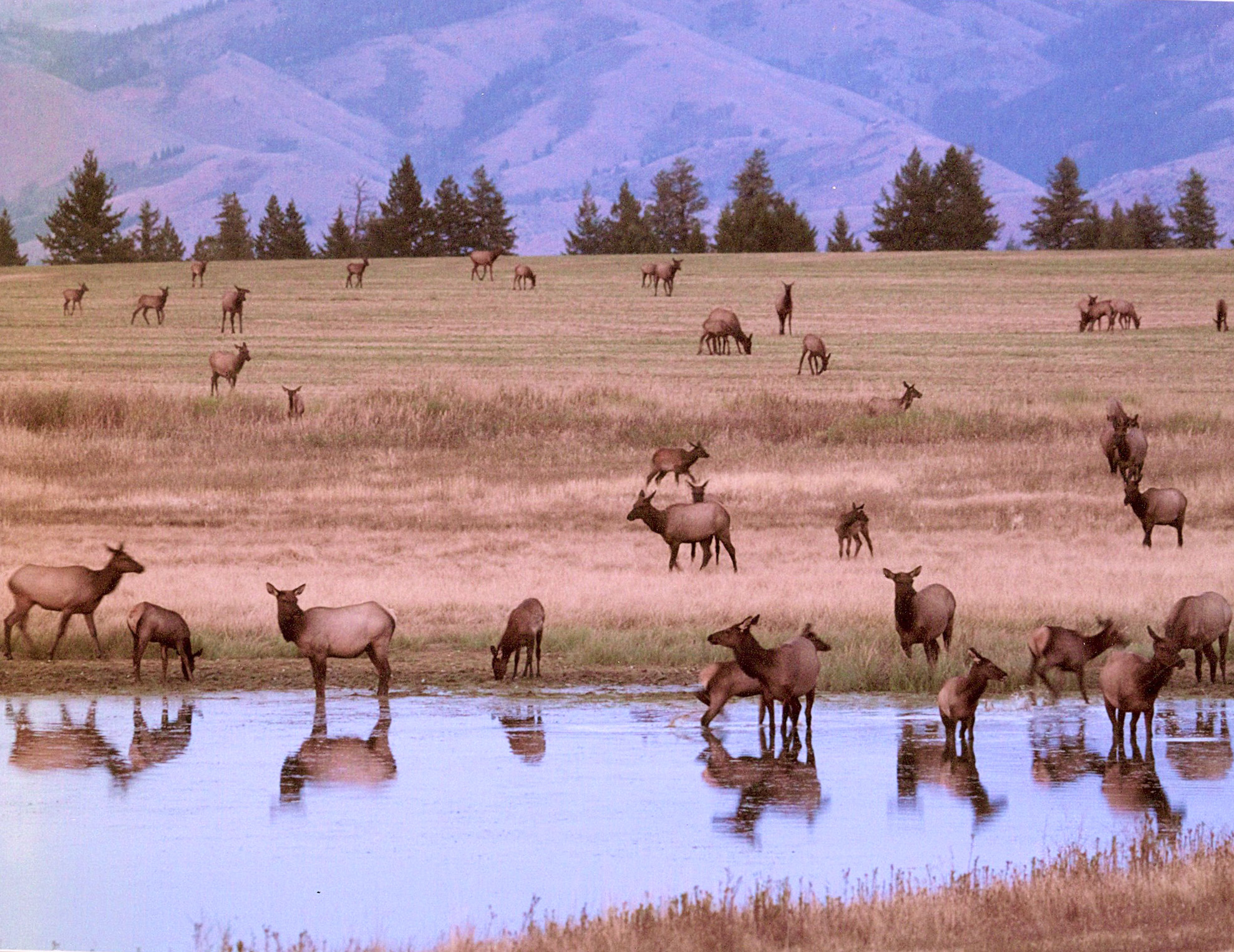Deer hunters in Kansas turned out in force last month to kill House Bill 2672, which would have allowed landowners to receive one deer permit for every 80 acres of Kansas ground they own. The deer tags would have been transferable, meaning they could have been sold to any resident or non-resident deer hunter, essentially turning every Kansas farmer into a big-game outfitter.
The bill passed the state’s House Committee on Agriculture and Natural Resources Budget, partly on the strength of its sponsor, hunting outfitter and committee chair Rep. Ken Corbet. But after a buzz saw of opposition from resident deer hunters, the bill was unceremoniously removed from the House calendar, meaning it’s effectively dead.
A new analysis of New Mexico’s elk-tag distribution indicates that last year 35 percent of available licenses went to non-residents, the vast majority distributed in the Elk Private Land Use System, which provides landowner tags that can be sold to the highest bidder.
Utah has had transferable landowner tags for years, and the state’s Cooperative Wildlife Management Unit program that distributes them is popular for guided big-game hunters who don’t have to wait through years of drawing for tags available to the public.
And Montana’s Fish, Wildlife & Parks Department this spring is issuing landowner elk tags to non-residents who own huge ranches. The controversial measure approved by the 2023 Legislature gives priority in the draw to non-resident landowners who own at least 2,500 acres, and additional tags for each 2,500 acres of land they own. Those tags are non-transferable, meaning they must be used by the person to whom they’re issued, but proposals to create transferable tags have been floated in the last several Montana legislative sessions.
Owners of private land, it seems, are increasingly asking for, and often getting, an edge when it comes to hunting or housing public wildlife. The trend is widespread enough to ask the question: What’s behind this movement to reward landowners for the presence of game animals on their land?
In some cases, it’s landowners’ frustration with damage to agricultural crops caused by public wildlife. In others, it’s seen as a way to diversify a ranch’s income stream. In others, it’s an expression of property rights being enacted by legislatures with conservative supermajorities.
Whatever the reason, the movement is exposing tension around competing ideas of ownership. Private landowners are, in many ways, the epitome of the promise of America, the idea that citizens can own land and determine what happens on their own private property. But since the Supreme Court’s 1842 ruling in Martin v. Waddell that resolved a property dispute over who had the right to harvest oysters in coastal New Jersey, wildlife has been determined by courts to be a public resource. According to that determination, private property rights are superseded by public rights to manage wildlife. That’s why landowners overwhelmingly require state-issued hunting licenses, for instance, to harvest wildlife that might spend its entire life on their private property.
The oyster-bed ruling, along with later court decisions, established what’s known as the public trust of wildlife, an expectation that state governments manage wildlife (and fish, and oysters) in public trust for all citizens. In other words, no private landowner can own the public wildlife on their land. They can control access. They can benefit from the presence of wildlife, as commercial outfitters often do. And they can seek compensation for damage to fences of forage caused by wildlife, as many Western landowners do. But there are limits to government responses. Most Western wildlife agencies require landowners to provide public hunting access as a condition for responding to game-damage complaints, for instance.
But legislative enthusiasm for transferable tags seems to be eroding the long-established expectation that wildlife are “a condition of the land,” and that landowners must accept the presence of public wildlife as the price for owning a chunk of their habitat.
Is the move to privatize wildlife coordinated, or are transferable-tag efforts more homegrown?
“The privatization of wildlife has become a trend in state legislatures, commission meeting rooms, and state agencies across the country over the last several years, says Charlie Booher, a wildlife lobbyist at the firm Watershed Results. “It’s clear that this movement isn’t merely a series of one-off events, but that it is a cohesive effort that poses a substantive threat to our outdoor and sporting heritage. It’s not entirely unlike the organized anti-hunting agenda that we’re all too familiar with, but the motivations of those behind this effort are different. It’s been my experience that these folks want to do good by family farms and ranches that are hurting, and I share that goal. But there are lots of ways to help private landowners when it comes to wildlife, and some are better than others.”
The Case of Machine-Gun Rathbone

For most of the late 19th and early 20th centuries, America’s market-hunting and homesteading eras pretty much made wildlife conflicts irrelevant, because wild animals were scarce and neither wildlife habitat nor conservation was a national priority. But following the emergence of state wildlife agencies, regulated hunting, and the establishment of game lands and habitats, wildlife responded by growing in population and distribution.
In Depression-era Montana, elk populations grew so fast that they started leaving their protected wilderness habitats and intruding on the lush grass of working ranches. One of those ranches, the Circle H, was located along the Rocky Mountain Front near the town of Augusta. The ranch manager, a straight-talking stockman named C.R. Rathbone, became so exasperated dealing with busted fences and grazed-down hayfields that he placed an advertisement in the Great Falls Tribune, seeking “people with machine guns and other means” to help kill 1,000 elk on the Circle H.
It’s unclear what response he got, but Rathbone himself telegraphed the state Fish and Game Commission on March 3, 1939. “We are killing elk on our ranch stop advise quickly disposition of carcasses.”
The next day a game warden found a freshly killed elk and arrested Rathbone for hunting in a closed season. The case went all the way to the Montana Supreme Court, which upheld Rathbone’s conviction. The high court’s opinion, handed down in March 1940, has been widely quoted. It reads:
“Wild game existed here long before the coming of man. One who acquires property in Montana does so with notice and knowledge of the presence of wild game [italics added] and presumably is cognizant of its natural habits. Accordingly a property owner in this state must recognize the fact that there may be some injury to property or inconvenience from wild game for which there is no recourse.”
It’s worth noting that much of the Circle H Ranch was later purchased with hunting-license funds and became part of Fish, Wildlife & Parks’ Sun River Game Range, protected as critical winter range for elk, mule deer, and other wildlife.
Managing for Abundant Wildlife
Our wildlife restoration efforts have worked too well in some places. Over a couple human generations, we’ve moved from a climate of wildlife scarcity to one of plenty. And private land, with its relative abundance of water, food, and cover, typically has higher wildlife habitat values — and wildlife presence — than adjacent public land.
The problem is, state wildlife management policies that were created in the scarcity era aren’t equipped to address wildlife abundance, says Chuck Denowh, of the United Property Owners of Montana, a group that has lobbied the legislature for landowner preference, transferable tags, and in 2022 sued the state’s wildlife agency for allowing elk populations to “grow to crisis proportions.”
“I can tell you from the perspective of our members, there certainly is a growing frustration among landowners who feel that they’re taking on an ever-increasing burden from big-game populations that compete with feed and forage for livestock,” says Denowh. “Policies like transferable tags are a reaction to the outcry that we hear from landowners about the over-abundance of wildlife.”
Another argument for transferable tags, that they are an incentive to protect critical habitat, has been floated by the Montana-based Property and Environment Research Center. The free-market conservation think-tank detailed in a 2021 policy brief that “transferable landowner hunting permits can help achieve state wildlife management goals and encourage voluntary conservation on private lands.”
Supporters of incentive-based conservation often point to a perspective from Aldo Leopold in his foundational book on ecology and eco-system management, A Sand County Almanac: “Conservation will ultimately boil down to rewarding the private landowner who conserves the public interest.”

Denowh stresses that the tension between public wildlife and private land is exaggerated, because he doesn’t believe the concept of public trust applies to wildlife.
“It’s been misapplied,” says Denowh. “In jurisprudence, the public-trust doctrine refers to a very specific set of common law that goes back almost to our founding, but it deals with water and shorelines and waterways. Applying it to terrestrial wildlife is a convenient legal theory that has no basis in law. It confounds how our wildlife commissions operate when you have some people calling for adherence to a legal theory that no legislature has ever empowered.”
Hogwash, says David Willms, associate vice president for public lands for the National Wildlife Federation. While it might not be spelled out in statutes or constitutions, he says you can see evidence of the public-trust doctrine in laws like the Lacey Act, which acknowledges states’ roles in wildlife management by penalizing the interstate movement of wildlife that was acquired in violation of state law. You see it in the U.S. Constitution’s 10th Amendment, which gives states power not explicitly given to the federal government, and also in the Constitution’s Property, Treaty, and Commerce clauses that courts have pointed to affirm the states’ and federal government’s roles in managing wildlife.
“You see the federal courts implicitly upholding the public trust doctrine in cases challenging state hunting license allocation and in wildlife management decisions on federal lands by recognizing states’ ability to conserve and manage wildlife,” says Willms. “That’s evidence of the trustee status of the state as it bears on wildlife management.”
Questioning the public-trust doctrine is a waste of breath, says Willms, whose stronger interest is defining which landowner-preference programs are in the public’s interest versus which are public-trust giveaways.
Alternatives to Public Wildlife “Giveaways”

“I don’t think anybody can ignore that there are landowners who have to deal with the impacts of wildlife,” says Willms. “Hunters and state wildlife agencies have an obligation to keep these landowners [economically] whole, partly because private land provides some of our best habitat for public wildlife. But I wish we were having more creative conversations other than simply providing transferable tags to landowners to sell opportunities to the public’s wildlife.”
Alternatives include walk-in programs that pay landowners to allow hunters access to problematic wildlife populations, habitat-lease programs that incentivize landowners for keeping native habitat from being paved or plowed, conservation easements that keep working farms and ranches from being subdivided.
“In the last several decades state wildlife agencies have put more and better tools in the toolbox to help landowners,” says Booher. “Wildlife management must include collaborative relationships with landowners, and we ought to have more of these relationships than we do right now. But there are important questions that need to be answered when it comes to privatizing wildlife.”
Using New Mexico’s Elk Private Land Use System elk tags as an example, Booher says these landowner-preference licenses can be looked at a couple ways.
“Landowner advocates will tell you that without these transferable tags, New Mexico’s ranches will be subdivided into oblivion, and that we’ll lose elk, elk habitat, and elk hunting forever,” says Booher. “But the opponents will tell you that all these transferable tags are doing is selling New Mexico’s public wildlife to the highest bidder.”
